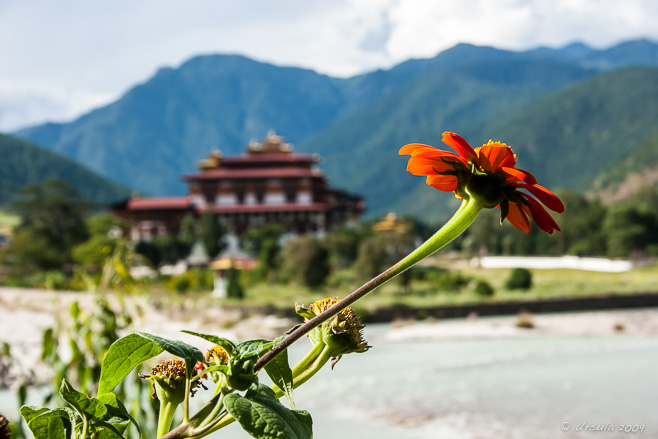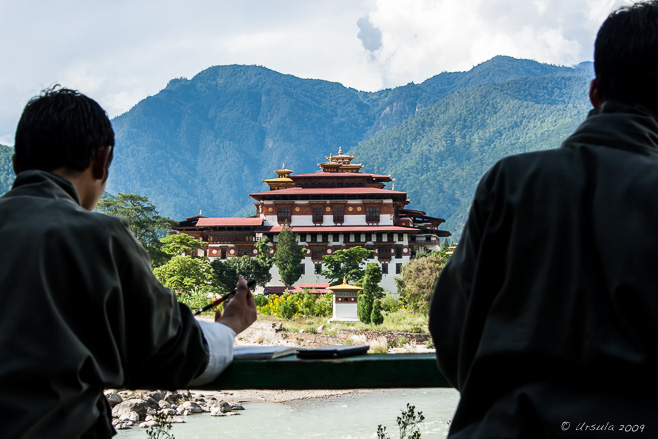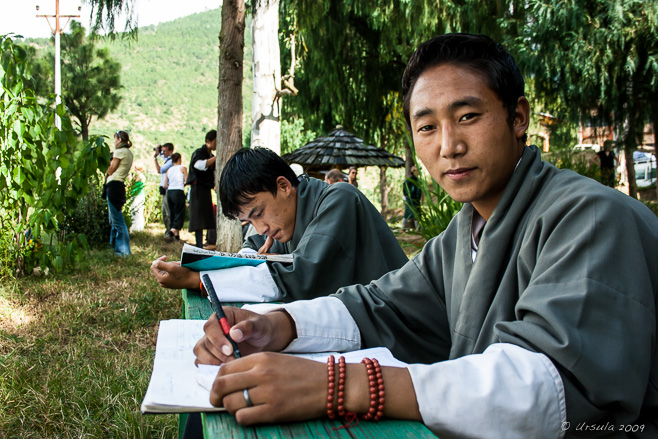
Autumn Flower and Punakha Dzong
Autumn (September-November) is one of two high-seasons for tourists in Bhutan – and for good reason: the skies are clear, the days are warm and sunny, and the colours are bright.
“The palace of great happiness or bliss.”
That is how Pungtang Dechen Photrang Dzong translates from Bhutanese.
Also known as Punakha Dzong, it has been an auspicious fortress for many years. Punakha Dzong was the seat of the Government of Bhutan until they moved the capitol to Thimphu in 1955. It is still the administrative centre for the Punakha District, and houses a number of precious religious relics.
According to legend, this dzong, or place-fortress, was predicted by Guru Rinpoche (Padmasambhava), the founder of Tibetan Buddhism. He is reputed to have said that: ‘…a person named Namgyal will arrive at a hill that looks like an elephant’. When Ngawang Namgyal, a Tibetan lama, found the elephant-like hill at the confluence of the rivers Pho (father) Chu and Mo (mother) Chu in the Punakha–Wangdue Valley, he built the dzong as foretold.
Constructed between 1637 and 1638, Punakha Dzong is the second oldest and second largest dzong in the kingdom. It is considered one of the most beautiful and is a joy to explore.
I was there late on a beautiful September afternoon in 2009 as part of a group with photographers Gavin Gough and Jackie Rado. Spring and Autumn are high tourist-seasons in Bhutan, and we were not the only photo-group in the ancient building; keeping other photographers out of my pictures was one of the challenges I faced as I wandered around and marvelled at this architectural wonder.

Doing Homework
Across the river from Punakha Dzong, senior high-school students are doing their mathematics homework. I can’t see the elephant trunk myself, but it is a gorgeous view!

Doing Homework
The young men, in their final year of high school, were a delight to chat with: thoughtful and articulate, with reasonable English.

Punakha Dzong Entry Bridge

Bhutanese School Girls

Monk Walking
The interior of the dzong is beautifully decorated…

Monks Walking
… with carved woodwork, colourfully painted.

Banister Detail
The carved and painted details around the dzong are rich in eight-spoked wheels and other Buddhist symbolism.

Venerable Monk

Young Monk

Lattice and Lace

Security Officer
People stand in angle-lit doorways…

Young Monk
… as if they are just waiting to be photographed.

Chorten and Bhodi Tree
In the northern courtyard, a sacred bodhi tree is growing in front of a huge white chorten.

Venerable Monk
I cautiously worked my way into where two monks were conversing…

Venerable Monk
… so I could gain permission, wordlessly, to take photos of them.

Guides Chatting
In their gho -traditional knee-length robes – and kabneys – silk shawls – two guides chat.

Old Wood and New Locks

Roof Detail

Guru Rinpoche in an Alcove

Monks in Late Afternoon Light

Three Sisters
Local children pose spontaneously together as I cross over the bridge again …

Monk Saying his Prayers
In the late afternoon, a Venerable walks rounds with his prayer beads.

Following the Hills
… and we leave the temple.
 Pungtang Dechen Photrang Dzong was the first major dzong I visited – and exploring it was, indeed, cause for “great happiness or bliss”.
Pungtang Dechen Photrang Dzong was the first major dzong I visited – and exploring it was, indeed, cause for “great happiness or bliss”.
Till next time ~
Mettā
Photographic notes: pictures taken 25September2009 with my old Canon EOS 400D – edited in Lightroom 5.



.jpg)

























.png)

